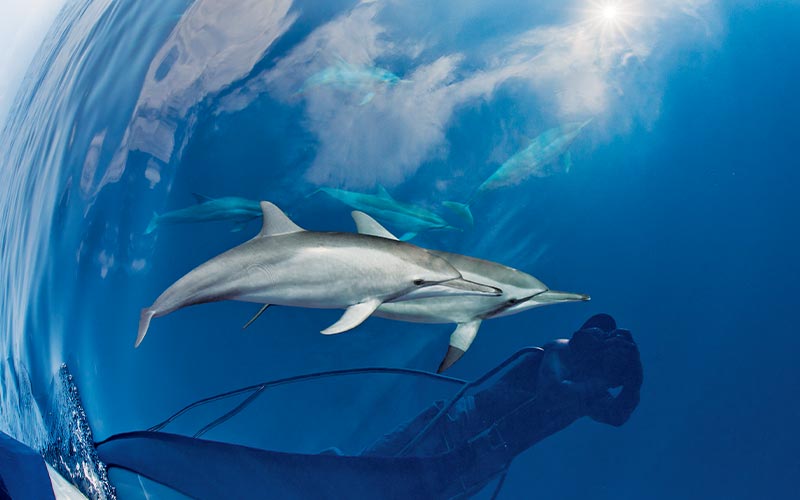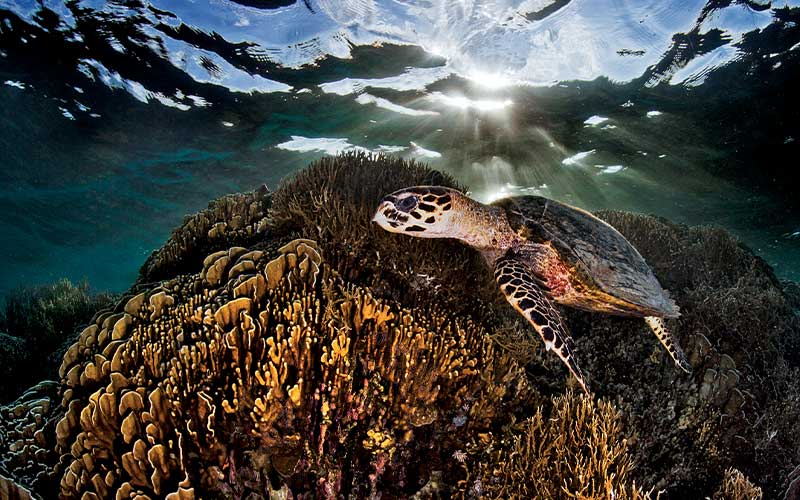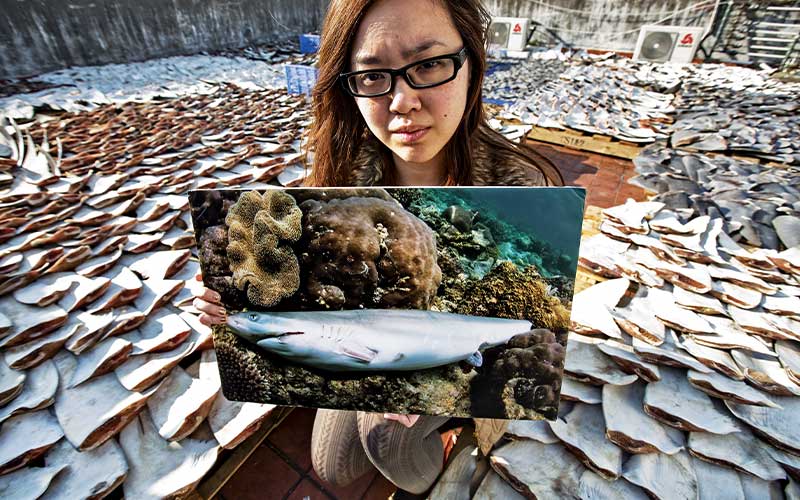The vast reach and immediacy of the Internet has made it easier than ever to spread awareness about and begin to address the many pressing challenges facing our oceans. As divers, we care that too many sharks are being brutally extracted from the ocean for something as wasteful as shark-fin soup. We care that manta rays are being slaughtered for their gill rakers, which are dried and ground into pseudo medicines. And we are appalled to learn that shark finners — willing to eradicate entire species for short-term personal gains — have even targeted the majestic whale shark. But documenting the shark-fin and manta gill-raker trades would mean little if word never got out and our collective conscience weren’t engaged.
We need someone to be the storyteller. Someone has to be there first — in distant places and sometimes threatened by the same unscrupulous profiteers responsible for exterminating these species. It isn’t an easy job; it involves long, tedious periods of research and travel interspersed with adrenaline-fueled infiltrations of secretive organizations to capture images of their operations. Paul Hilton — a shooter of great personal integrity — is one of these storytellers.

Hilton was born in England and raised in Australia. Growing up in North Queensland, he spent his childhood in and around the ocean, gaining an appreciation for marine life. His parents were similarly environmentally-minded; he remembers his mother caring for injured animals that had wandered into their backyard and writing to the Australian government about proper care for whales. Thinking back on those formative years, Hilton believes his direction might have been forged merely by being taught the value of wildlife.
During high school he assumed he would graduate and go into the Parks and Wildlife Service, but upon further reflection he realized that might mean being assigned to a specific park, and he needed unconstrained horizons. So he went back to the beach and worked as a surf lifesaver, helping swimmers in trouble and providing first aid for box-jellyfish stings and other local hazards.

But he was restless, and he soon took off to hitchhike around Australia. He decided that he’d travel until he ran out of money, when he’d get a kitchen or fruit-picking job, replenish his reserves and move on. Eventually, he and his mates purchased a tired Kombi van in Alice Springs, which later took him to Sydney, where he moved onto a boat and into his next chapter: hitchhiking through Indonesia and then, for yet another change of scenery, Europe.
Growing up, Hilton enjoyed wildlife and beach photography. Being a photographer was a dream job, but he never imagined it might actually pay the bills. When he ended up in London in 1991 there was a very active culture of commercial and fashion photography, so he bought a Canon single-lens reflex (SLR) camera and enrolled in a six-week course at the Kennington School of Photography. He learned to develop and print his own photos and assimilated the science of his craft.

After some time in London, Hilton traveled to Hong Kong and then back to Australia for a while. In the course of these travels he built a significant portfolio. When he bounced back to Hong Kong he had enough experience to land a job with Michel Porro, a successful commercial photographer. He learned to shoot with 4×5 view cameras and use Polaroid backs, and he became adept at corporate portrait work. He went out on his own a few years later, doing events, food and beverage photography, portraits, product illustrations and architectural work.
Meanwhile, Hilton retained his passion for the wild and by 1996 was doing pro bono work for the World Wildlife Foundation and others. His first real conservation story documented bear bile farms in China for the Animals Asia Foundation. Bear bile farms imprison Asiatic black bears in tiny cages where they can hardly move, sometimes for 10 years or more. While immobilized, the bears receive stainless steel catheters, which are inserted into their gall bladders to harvest bile. Bear bile is used, ostensibly, to treat liver ailments, tapeworms and even the common cold. When the Chinese government finally shut down many of these farms, the surviving bears were riddled with cancer. It was an awful story to shoot — gut wrenching and emotional — but it resonated with the public. National Geographic ran it in 2001, and it also appeared in the South China Morning Post and Asian Geographic. It was then that Hilton first understood how his images could make a difference, and his life’s direction took a dramatic turn.

STEPHEN FRINK// It was a big change from bear bile farms in China to the cause we most associate with you: shark finning. How did that come about?
PAUL HILTON// I was living in Hong Kong in 2005, and shark finning was out of control. Every store you went into, whether to buy beer or bread, seemed to have shark fins for sale. I knew there was no way this was a sustainable industry — there just couldn’t be that many sharks out there. But I can’t say I really understood the issue. That was a time in my life when corporate photography wasn’t so important to me anymore, and then the severe acute respiratory syndrome (SARS) virus hit Asia, and advertising photography dramatically slowed as budgets dwindled. I wanted a new direction for my photography anyway, so I became a stringer for the European Pressphoto Agency (EPA). That meant I was on retainer to shoot news features, which taught me about the infrastructure of news wire services. Stories I shot could have an audience — quickly and with massive distribution. I would have a voice. Between the stories I was shooting for EPA and Bloomberg News, I could travel, shoot, file and still have time for my own projects. Shark finning was a long-term project I began then.
You might remember the big controversy that year when Disneyland was opening in Hong Kong. I was in the running to get some of their commercial photo work, but then a lot of my photos were used in news stories that showed the park’s menus included shark fin soup. Needless to say, I didn’t get that contract, but in the ensuing uproar Disney dropped the soup from the menus. So it all worked out for the best.

Shark finning was a story that needed to be understood and told quickly — before shark populations were further decimated. I collaborated with fellow photographer Alex Hofford on a book called Man and Shark to show the world what it really meant to cut the fins off a shark in the wild and get them into a bowl of soup in China. That
meant traveling to Mozambique, where shark carcasses were fouling beautiful beaches. We needed to document the Taiwanese buyers working the coast of Africa, buying shark fins from villagers. This meant dealing with the mafia in South Africa, because they controlled the industry there. We also went to Yemen to document shark finning in the Red Sea. That, in particular, was edgy. We’d go into a restaurant, and there would be an AK-47 on every table. We didn’t stay there very long.
We printed the book in both English and Chinese and got it into the schools in Hong Kong. That was quite significant, and I think it was a wake-up call for the Hong Kong public. We had a series of photo exhibitions around town at the same time. The kids know instinctively that the practice is wrong, and they can shape their own future actions and influence their parents and grandparents. It helped kick-start the movement in Hong Kong, and shark fin soup is now becoming far less fashionable.

SF// Much of your work in marine-life conservation is underwater, yet most of the photography you’ve mentioned is either commercial or topside documentary. When did you get into underwater photography?
PH// By 2007 I was shooting the land-based shark fin coverage; I also had a Nikonos, but I didn’t really use it much. But then Greenpeace International came to me with an offer to travel to the Pacific to document whale tagging that was being done to determine migration patterns. This was a dream job, so it wasn’t like I was going to say no, even though I really didn’t know how to shoot underwater. So I borrowed a Subal housing for my Canon camera, and off I went to the Cook Islands and later Tonga to photograph everything that had to do with the whale trail.
This was a life-changing event. I brought my wife and daughter with me to Tonga, and being that close to humpbacks was an experience we’ll never forget. Words can’t really describe it. It made me think more about the ocean as an ecosystem, and the success of the coverage brought more assignments from Greenpeace, including work in the Mediterranean and Indian Ocean and the acquisition of general beauty images to illustrate the biodiversity of the world’s oceans.
I had a skill set that was marketable, especially as my underwater photography matured. I was already quite good at shooting land-based images, which gave me an advantage over some underwater-only photographers. I’m grateful that my clients keep coming back with more assignments.

SF// Portrait photographers have to get their subjects to open up to them. Your coverage is a blend of portrait, street and conflict photography. How do you get your subjects to open up to you? How do you get them to smile with a knife in one hand and a shark fin in the other, when they must know that your photos, if they do their job, will put them out of business?
PH// I’m not sure they really think it through to that degree or that these people are so media savvy that they understand what my photos might mean relative to what they are doing — that these images will have consequence. But to answer your question, you have to be able to read their body language and even without words be able to project an air of friendly, nonconfrontational behavior. Of course, I also adhere to the old maxim, “It is better to beg forgiveness than ask permission.” I do a lot of that.
In a potentially heated situation I may take only one photo and have to make it count. Then I can ask questions and even apologize if I have to. But I will have the shot. The scene can get sketchy; these people often have a sense that what they are doing is not exactly right, but if I come off as a green tourist I can usually pull it off.
SF// I was in my car recently listening to the BBC on the satellite radio. The voice coming through the speakers was yours. That was kind of surreal because we had just traded our first emails about doing this story, and there you were talking about seeing factories in China that were processing whale-shark carcasses for their fins.
PH// That was a good example of where stealth photography was necessary. In 2010 we had a tip from a nongovernmental organization (NGO) that there was a whale-shark processing plant in China. They took everything from the whale shark: the fins, of course, but also the skin and the oil. They also had basking sharks and, thanks to a conclusive DNA sample, we know there were great white sharks as well. Just do an online search for “China whale sharks” and you’ll get a sense of how widely circulated this coverage has become. Many of the factories have closed down as a result.
I went undercover, posing as a buyer. I took a simple compact camera, a Canon PowerShot G11, and for the most part kept it in a bag as I walked around this courtyard that had whale-shark carcasses strewn all about. Every so often I would pull out the camera, grab a shot, and then move on, looking nonchalant.
It is a weird scene; the people at the fisheries end of the chain are hard-working people doing an honest day’s labor by their standard. The corruption comes farther up the supply chain, and the true culpability is with the consumer. If no one bought shark fins, no one would bother catching sharks with longlines, cutting off their fins and dumping the still-living creature back into the sea to suffocate on the bottom.

SF// Manta rays are similarly in trouble these days because they are being harvested for their gill rakers. Who would even think of doing such a thing? How did you get involved with that reportage?
PH// In 2007 I was still deeply entrenched in my shark fin stories, and I took some time out to go on a surf trip with my buddies. I clearly remember when I saw it first, and how shocked I was. It was 4 a.m. in a village in Indonesia, Tanjung Luar. Masses of dead manta rays were strewn around the beach, and the villagers were cutting them up. They all had large bits of flesh excised, which I soon learned were the gill rakers.
In 2009 I documented the gill-raker trade again in Sri Lanka. We followed the gills to a warehouse and discovered they were being consolidated for shipment to Hong Kong and China. Guangzhou in southern China is ground zero for the gill-raker trade, with shop after shop selling gill rakers from manta and mobula rays. It was apparent to me that the demand was only increasing. The trade was not widely known in the West — perhaps not at all.
The “Manta Ray of Hope” coverage of this trade has been so powerful that the Convention on International Trade in Endangered Species (CITES) listed manta rays in its Appendix II in 2013, and now all of Indonesia is now a manta ray sanctuary. As is true anywhere, sanctuary status is meaningless without enforcement, but establishment of the sanctuary has definitely helped raise awareness of the issue.

SF// I’m sure you take more than just your Canon G11 when you go on assignment. What is in your travel kit to document the things you see?
PH// I take a pair of Canon EOS 5D Mark III bodies and a Subal housing with Ikelite DS161 strobes for the underwater work. I also carry a Canon EOS-1D Mark IV, which is my workhorse camera. I love it for the rapid motor drive and high ISO capability. For lenses I carry the Canon 16-35mm II, a 15mm fisheye, a 70-200mm zoom and a 300mm f/2.8 for those things that I need to cover but can’t really risk getting too close to.
SF// Being immersed in these stories, can you be optimistic about the ocean and its creatures?
PH// Optimistic might be too strong a word, but I’m definitely hopeful. I believe it is still possible to turn this around. Shark-fin sales are down 50 to 70 percent in China, and on that one particular issue we have made a difference, but there is still much more work to be done. I think we affected the whale-shark fishery, and I hope we told the manta ray gill-raker story in time to slow down the trade.
Female mantas give birth to just one pup at a time. They can take up to 10 years to reach breeding age. The egg hatches inside the mother’s body, and the offspring are born alive. The pups know how to swim the moment they hit the water and can care for themselves immediately. Mom doesn’t stick around, and there is extremely high mortality in that first year of life. So extracting adult manta rays from the wild can have a significant impact on populations very quickly.
On the upside, China is trying to make a move to protect endangered species and recently announced a list of 420 species, including sharks and bears, that will receive better protection.

Everybody wants to point the finger at China, but they are really trying to improve. However, at the same time they are facing some pretty daunting issues in the not-too-distant future, such as how they are going to provide water and power for their enormous population. The water table under Beijing has dropped 1,000 feet in the last 10 years alone.
I don’t think you can do what I do for a living and be optimistic exactly, but I know we can make a difference. We have seen it with shark fins and bear bile. I’m hoping we might see it in other issues such as the deforestation for palm oil plantations in Sumatra. There is no shortage of stories out there. I’d like to be out of work in documentary environmental activism, but unfortunately, I think I have job security for years to come.
Of course I worry about what we will leave for the next generation. What will be the future of the oceans, and what kind of environment will my two daughters inherit from our generation? But I can get away from the gloom and doom and still appreciate and photograph the beauty that remains.
I am forever inspired by having once had the opportunity to document the humpback whale migration. That was one of the most incredible experiences of my life, and I’ve since swum with blue whales and other marine mammals. These are the things that most excite me, and I hope my photography will, in some small way, inspire others to keep fighting the good fight.
The reality is that every one of us has the power to make a huge difference.
© Alert Diver — Q3 Summer 2014